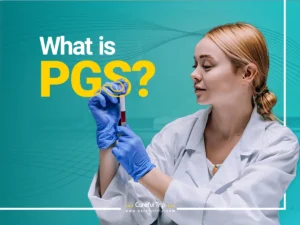
What is PGS (Preimplantation Genetic Screening)?
Around 50% of human embryos created during IVF are chromosomally abnormal before implantation, according to large-scale fertility studies. This rate increases with maternal age and is a major cause of failed implantation and miscarriage. To improve IVF success rates, many clinics now offer Preimplantation Genetic Screening (PGS), also known as PGT-A (Preimplantation Genetic Testing for Aneuploidy), to assess embryos for chromosomal abnormalities before transfer.
Fertility specialists offer a solution for this group of people who may face the problem of abnormal chromosomes, which is called PGS. Preimplantation Genetic Screening (PGS) refers to the removal of one or more cells from an IVF embryo to test for chromosomal normality. As you know, humans naturally have 23 pairs of chromosomes, making a total of 46 chromosomes. The presence of an extra chromosome or the absence of a chromosome, less than 46 chromosomes, will cause genetic abnormalities, and this is where PGS comes in to test and screen the embryo for a normal chromosome number.
For example, Down syndrome patients have an extra copy of chromosome number 21, which PGS can detect before birth. Of course, PGS is not applicable for specific diseases such as cystic fibrosis or hereditary diseases, and these types of diagnoses will be the responsibility of PGD; Preimplantation Genetic Diagnosis. In this guide, we’ll break down how PGS works, who it’s recommended for, its benefits and risks, and why more patients are choosing to do PGS as part of their IVF in Iran.
What Is PGS?
PGS (or PGT-A) is a genetic screening test performed on embryos created during IVF. Its purpose is to check for aneuploidy — extra or missing chromosomes — which are a leading cause of:
- Failed embryo implantation
- Early miscarriage
- Certain genetic conditions, such as Down syndrome (extra chromosome 21), Turner syndrome (missing X chromosome), or trisomy 18
Each healthy human embryo should have 46 chromosomes, arranged in 23 pairs. Even a single error in this count can make an embryo nonviable or lead to serious developmental problems. PGS screens for these abnormalities before the embryo is transferred to the uterus, helping doctors select only chromosomally normal embryos for implantation.
PGS does not test for specific genetic diseases like cystic fibrosis or thalassemia. For that, another test called PGD (Preimplantation Genetic Diagnosis) is used.
How Is PGS Testing Done?
If you read anywhere or hear from anyone about doing the PGS process, you may come across different classifications and designations. But we have categorized the steps of doing PGS into 8 steps so that you can get a good understanding of what is ahead of you.
Step 1 – Ovarian Stimulation:
The process begins with hormone injections that stimulate the ovaries to produce multiple eggs. This typically starts on day 2 of the menstrual cycle and continues for 10–12 days, with ultrasounds every few days to monitor follicle growth. When follicles reach the ideal size, a final “trigger shot” is given to mature the eggs.
Step 2 – Egg Retrieval:
Eggs are collected under sedation using ultrasound-guided aspiration. An embryologist then assesses the total number of eggs and how many are mature and suitable for fertilization.
Step 3 – Fertilization (IVF or ICSI):
The mature eggs are fertilized using one of two methods:
- IVF: Eggs and sperm are placed together in a petri dish, allowing natural fertilization.
- ICSI: A single sperm is directly injected into each mature egg — often used in cases of male infertility.
Step 4 – Embryo Culture
Once fertilization occurs, the resulting embryos are placed in a specialized culture medium and allowed to grow in the laboratory. Over the next 5 to 6 days, they develop from a single cell into a blastocyst — a complex structure with over 100 cells. Embryologists monitor each embryo’s development closely, assessing quality, cell division rate, and morphology. Only embryos that reach the blastocyst stage with proper structure and growth parameters are considered for genetic screening.
Step 5 – Embryo Biopsy
When an embryo reaches the blastocyst stage (typically on day 5 or 6), a few cells are carefully removed from the trophectoderm — the layer that eventually forms the placenta. This biopsy does not involve the inner cell mass, which develops into the fetus. The biopsy is performed using micromanipulation techniques under a high-powered microscope and is only done by certified embryologists with extensive training. The biopsied cells are then sent to a genetic testing laboratory for PGS analysis.
Step 6 – Genetic Testing (PGS Analysis)
The biopsied cells undergo comprehensive chromosomal analysis using advanced technologies such as Next-Generation Sequencing (NGS) or comparative genomic hybridization (CGH). These tests check all 23 pairs of chromosomes to detect:
- Aneuploidy (extra or missing chromosomes)
- Structural abnormalities
- Mosaicism (presence of both normal and abnormal cells)
The goal is to identify embryos with a normal chromosomal complement (euploid) — those most likely to implant successfully and result in a healthy pregnancy.
Step 7 – Embryo Transfer
Once PGS results are available (typically within 7–10 days), the fertility team selects the best-quality euploid embryo for transfer. The embryo is thawed (if frozen) and transferred into the woman’s uterus using a thin catheter under ultrasound guidance. To minimize the risk of multiple pregnancies, one or two embryos are typically transferred per cycle, depending on age, history, and clinical judgment. Remaining normal embryos can be cryopreserved for future use.
Step 8 – Pregnancy Testing
About 10 to 14 days after the embryo transfer, a blood test is performed to check for the pregnancy hormone hCG (human chorionic gonadotropin). A positive test confirms implantation. If the levels rise appropriately over subsequent tests, the clinic schedules an early ultrasound to confirm a viable intrauterine pregnancy.
PGS Testing Time Duration
Once the embryo biopsy is completed and the cells are sent to a genetic lab, results are typically available within 7 to 10 days. This timeline may vary slightly depending on the clinic and testing lab, but most patients can expect results within two weeks of the biopsy.
Who Should Consider PGS?
While anyone undergoing IVF can opt for PGS, it is particularly recommended for patients in the following categories:
- Women aged 35 or older, who have a higher risk of producing chromosomally abnormal eggs
- Couples with multiple failed IVF attempts, despite transferring good-quality embryos
- Patients with recurrent pregnancy loss
- Individuals with a history of chromosomal abnormalities in prior pregnancies or embryos
- Couples using donor eggs or sperm, who want to maximize success in fewer transfers
PGS can be a valuable decision-making tool, especially when embryo quantity is limited and patients want to avoid unsuccessful transfers.
Benefits Of PGS
PGS offers several important advantages, including:
- Higher implantation rates: Euploid embryos are more likely to implant and develop into a healthy pregnancy.
- Reduced miscarriage risk: Chromosomal abnormalities are a leading cause of early miscarriage. PGS helps avoid this.
- Fewer IVF cycles needed: By identifying the most viable embryos up front, patients may reach pregnancy faster and with fewer transfers.
- Informed family planning: If all embryos are abnormal, patients can consider options like donor eggs or sperm sooner, rather than undergoing failed cycles.
Risks Of PGS
PGS is a highly advanced and generally safe procedure — but like any medical intervention, it has risks and limitations:
- Minimal embryo risk: The biopsy process is delicate, but when done by an experienced embryologist, the risk of damaging the embryo is under 1%.
- Not 100% accurate: PGS has an accuracy rate of around 97%, which means a small margin of error still exists.
- Cannot detect single-gene disorders: For specific hereditary diseases, PGD is required.
- False results due to mosaicism: Embryos with a mix of normal and abnormal cells can lead to inconclusive or misleading outcomes.
- No guarantee of pregnancy: A chromosomally normal embryo can still fail to implant due to uterine factors or unknown issues.
PGS Success Rate
If a euploid (chromosomally normal) embryo is transferred, studies show a 60–70% chance of live birth per transfer — significantly higher than the average success rate for IVF without PGS. However, this figure reflects outcomes only after an embryo is confirmed as normal and transferred, not from the start of the cycle.
Keep in mind: not all IVF cycles will produce embryos that are suitable for PGS or that pass the genetic screening.
Why Do PGS in Iran?
Iran has become a leading destination for fertility treatments, offering:
- World-class fertility clinics and embryology labs
- Highly trained IVF specialists and genetic scientists
- Affordable treatment costs compared to the U.S. or Europe
- Modern equipment and internationally recognized protocols
MOM Fertility Clinic in Tehran is one of Iran’s most reputable centers for IVF and PGS, with high success rates and advanced genetic screening capabilities. Through CarefulTrip, a trusted health tourism provider, international patients receive complete coordination — from medical appointments and testing to travel support and interpretation services.
Whether you’re pursuing IVF for the first time or adding PGS to improve your chances, Iran offers high-quality care at accessible prices, without compromising on technology or ethics.
Ready to Start?
CarefulTrip consultants are here to guide you through every stage of your fertility journey. If you’re considering IVF and PGS in Iran, reach out today for a free consultation and personalized treatment plan.
References:
- Frequency of Chromosomal Aneuploidy in High‑Quality Embryos: Fesahat et al., “Frequency of chromosomal aneuploidy in high-quality embryos and blastocysts”, 2017 — shows that even top‑grade embryos can have rates of chromosomal abnormality up to ~50%. PMC
- Arrested Embryos vs Blastocysts: Euploidy Rates: T. Qi et al., “Arrested human embryos are more likely to have abnormal karyotypes than developing embryos”, 2014 — finds that a very high proportion of embryos (both arrested & blastocyst stage) are aneuploid; only ~28.9% of blastocysts were euploid. BioMed Central
- ASRM’s Committee Opinion on Use of PGT‑A (PGS): The American Society for Reproductive Medicine (2024) published guidance showing aneuploidy rates by age group (e.g. ~52% for women <35, ~64.5% for women 35‑40). ASRM
- Preimplantation Genetic Screening and The Success Rate: Totonchi, M. et al., “Preimplantation Genetic Screening and the Success Rate …” (PMC, 2020) — this article explores how PGS/PGT‑A correlates with IVF success metrics. PMC
- Single‑Cell Sequencing & Mosaic Aneuploidy: Robertson et al., “Single‑cell sequencing shows mosaic aneuploidy in most human embryos” (2024) — provides evidence that many embryos categorized as “high quality” still exhibit mosaicism. JCI
- Chromosome Abnormality Rates in IVF Embryos more broadly: Y. Zhang et al., “Chromosome abnormality rates in human embryos: comparison of IVM and IVF embryos” (2010) — gives data points on % abnormal embryos in different IVF/IVM settings. RBMO Journal

